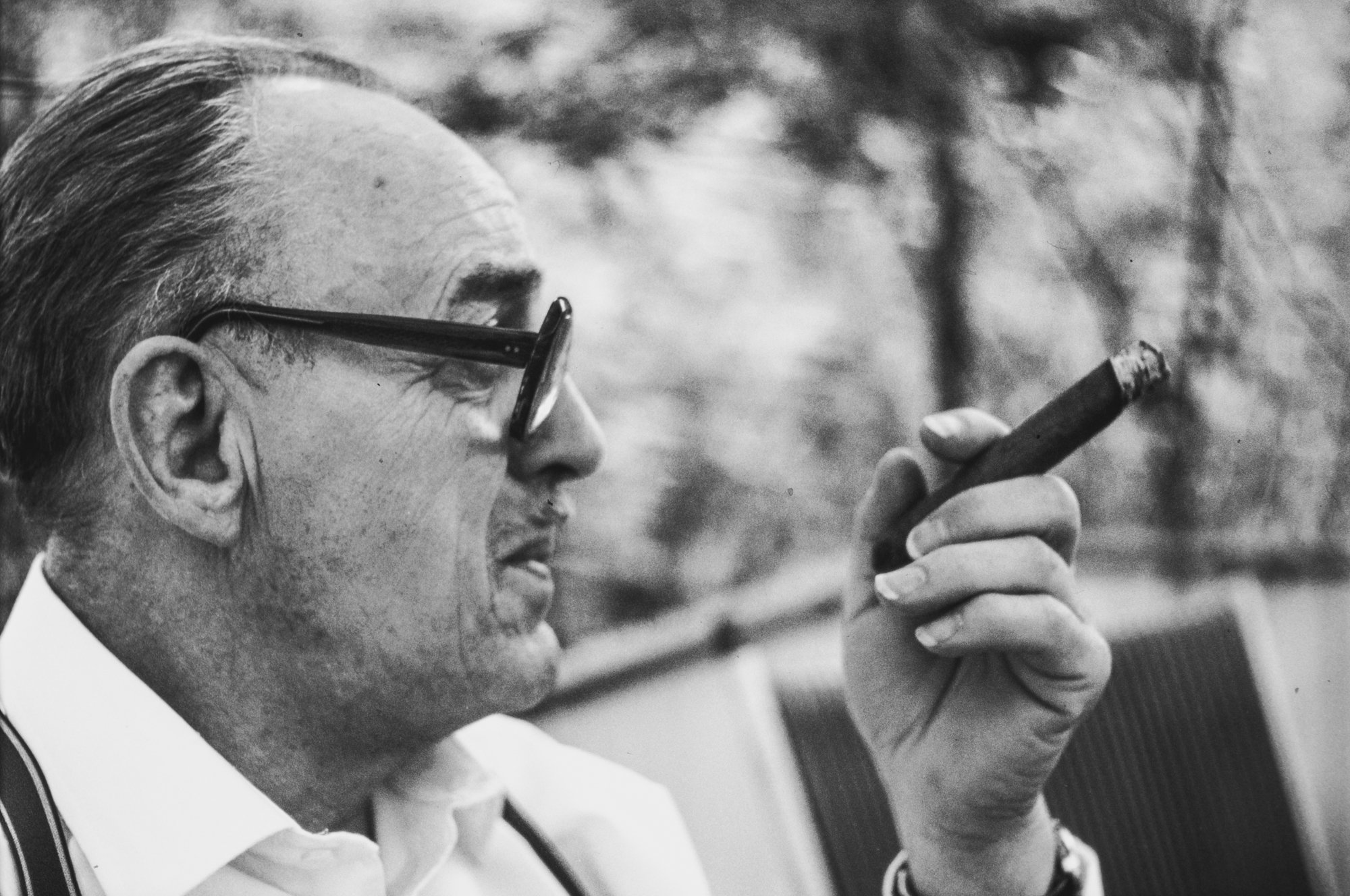Ein Meister aus Deutschland
Between Family Memory and Historical Symbolism
The photograph, taken from Matthias Koch's Todtnauberg series, presents a man seen in profile, cigar in hand, captured in an ostensibly ordinary moment. This man, revealed to be the photographer's grandfather, a former Nazi, imbues the image with a symbolic and memorial weight that transcends the simple aesthetic of the portrait.
A Figure of the Everyday, A Figure of History
The image juxtaposes the ordinariness of the gesture — smoking a cigar in a tranquil outdoor setting — with the moral and historical complexity of the individual depicted. The man’s face, his imposing glasses, his relaxed posture, suggest an apparent normality. Yet this normalcy becomes unsettling once we are aware of his past: it evokes the "banality of evil," a concept developed by Hannah Arendt to describe how ordinary individuals can become complicit in extraordinarily destructive acts within a totalitarian system.
This contrast between the everyday and the involvement in tragic historical events places this photograph within a broader reflection on the ambiguity of human figures, far from simplistic caricatures.
"Ein Meister aus Deutschland": The Burden of Corrupted Authority
Within the *Todtnauberg* series, this image dialogues with the figure of the "Meister aus Deutschland," the "master" mentioned by Paul Celan in *Todesfuge*. This master, symbolizing Nazi authority, represents the pernicious alliance between culture, power, and violence. Here, the cigar becomes an almost provocative detail, alluding to a certain dignity or arrogance associated with figures of power. The man’s tranquil posture evokes a double tension: the heavy ideological inheritance he carries and the apparent disengagement that the photograph freezes in a suspended moment.
An Ethical and Intimate Exploration
By choosing to photograph his own grandfather, Matthias Koch makes an audacious, almost provocative gesture, following in the tradition of artists who question their own familial heritage in the face of historical tragedies. The photograph is neither an act of accusation nor an attempt at rehabilitation. It invites contemplation, questioning, without offering simple answers.
The Todtnauberg Series: Memory and Landscape
This portrait resonates within the larger context of the *Todtnauberg* series, which explores an iconic site of intellectual Nazism through Heidegger and his cabin. Just as the landscape becomes a silent witness to past ideologies, the face of this man becomes a "human landscape," bearing tensions between the intimate and the universal, between history and family memory.
Viewing this photograph presents a fundamental ethical question: how can we represent, in art, those who were complicit in a criminal regime? Can we document without glorifying, expose without judging? The power of this image lies precisely in its ambiguity, allowing the viewer to navigate between discomfort and reflection.
This portrait, with its apparent simplicity, thus becomes a mirror held up to the viewer, a space where the intimate meets the weight of collective history.
Entre mémoire familiale et symbolisme historique
La photographie, tirée de la série "Todtnauberg" de Matthias Koch, présente un homme vu de profil, cigare à la main, capturé dans un moment apparemment ordinaire. Cet homme, révélé comme étant le grand-père du photographe, ancien nazi, projette sur l'image une charge symbolique et mémorielle qui transcende la simple esthétique du portrait.
Une figure du quotidien, une figure historique
L'image juxtapose la banalité du geste — fumer un cigare dans un cadre extérieur calme — avec la complexité morale et historique de l’individu représenté. Le visage de l'homme, ses lunettes imposantes, sa posture détendue, renvoient à une apparente normalité. Pourtant, cette même normalité devient troublante dès lors que l'on connaît son passé : elle évoque la "banalité du mal", concept développé par Hannah Arendt pour décrire comment des individus ordinaires peuvent devenir complices d’actes extraordinairement destructeurs dans un système totalitaire.
Ce décalage entre le quotidien et l’implication dans des événements historiques tragiques inscrit cette photographie dans une réflexion sur l’ambiguïté des figures humaines, loin des caricatures simplificatrices.
"Ein Meister aus Deutschland" : le poids d’une autorité pervertie
Dans le cadre de la série "Todtnauberg", cette image dialogue avec la figure du "Meister aus Deutschland", le "maître" évoqué par Paul Celan dans Todesfuge. Ce maître, symbole de l'autorité nazie, représente l’alliance pernicieuse entre la culture, le pouvoir et la violence. Ici, le cigare devient un détail presque provocant, renvoyant à une certaine prestance ou arrogance associée à des figures de pouvoir. La posture tranquille de l’homme évoque une double tension : celle d’un héritage idéologique lourd et celle du désengagement apparent que la photographie fige dans un instant suspendu.
Une exploration éthique et intime
En choisissant de photographier son propre grand-père, Matthias Koch fait un geste audacieux, presque provocateur, dans la tradition des artistes qui interrogent leur propre héritage familial face aux tragédies historiques. La photographie n'est ni un acte d'accusation, ni une tentative de réhabilitation. Elle invite à contempler, à questionner, sans apporter de réponses simples.
La série Todtnauberg : mémoire et paysages
Ce portrait trouve une résonance dans le cadre plus large de la série Todtnauberg, qui explore un lieu emblématique du nazisme intellectuel à travers Heidegger et sa cabane. De la même manière que le paysage devient un témoin silencieux des idéologies passées, le visage de cet homme devient un "paysage humain", porteur de tensions entre l'intime et l'universel, entre l'histoire et la mémoire familiale.
Regarder cette photographie, c’est être confronté à une question éthique fondamentale : comment représenter, dans l’art, ceux qui ont été complices d’un régime criminel ? Peut-on documenter sans glorifier, exposer sans juger ? La force de cette image réside précisément dans son ambiguïté, laissant le spectateur naviguer entre inconfort et réflexion.
Ce portrait, avec sa simplicité apparente, devient ainsi un miroir tendu au spectateur, un espace où l’intime rencontre le poids de l’histoire collective.

